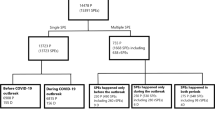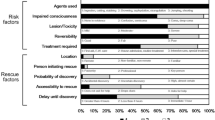Abstract
Purpose
The risk of death from suicide after self-poisoning has been known to be significantly higher as compared to the general population. Nevertheless, the change in suicide risk before and after self-poisoning is still unclear.
Methods
The database of territory-wide medical records collected by the Hospital Authority of Hong Kong was used to identify inpatients who have survived the first-ever self-poisoning but died by suicide between January 1, 2001, and December 31, 2010. A self-controlled case series (“SCCS”) design controlling for time-invariant patient confounders was used to explore the temporal change in suicide risk after the first self-poisoning episode.
Results
During the study period, 227 people in the database died from suicide after surviving one episode of self-poisoning. A significant increase of the risk of suicide in the first 12 months after the first lifetime self-poisoning—Risk Ratio (“RR”) 2.88 (95% CI 1.74–4.76)—was detected. The RR gradually returned to baseline levels after the second post-poisoning period.
Conclusion
By within-person comparison, the net increase of the suicide risk caused by the first self-poisoning was quantitatively modeled, demonstrating that the first lifetime self-poisoning event itself is a modifiable risk factor of subsequent suicide death.



Similar content being viewed by others
References
Swanson SA, Colman I (2013) Suicide “contagion”: what we know and what we need to find out. CMAJ 185:870–877
Centre for Suicide Research and Prevention, Suicide Rate—Centre for Suicide Research and Prevention, Last updated 2019, Accessed on 2019
Finkelstein Y, MacDonald EM, Hollands S, Sivilotti MLA, Hutson JR, Mamdani MM, Koren G, Juurlink DN, Dormuth CR, Raymond CB, Kozyrskj A, Moride Y, Paterson M (2015) Risk of suicide following deliberate self-poisoning. JAMA Psychiat 72:570–575
Rockett IRH, Regier MD, Kapusta ND, Coben JH, Miller TR, Hanzlick RL, Todd KH, Sattin RW, Kennedy LW, Kleinig J, Smith GS (2012) Leading causes of unintentional and intentional injury mortality: United States, 2000–2009. Am J Public Health 102:2000–2009
Langlois S, Morrison P (2002) Suicide deaths and suicide attempts. Health Rep 13:9–22
Lam SM, Lau ACW, Yan WW (2010) Over 8 years experience on severe acute poisoning requiring intensive care in Hong Kong, China. China Hum Exp Toxicol 29:757–765
Finkelstein Y, Macdonald EM, Hollands S, Hutson JR, Sivilotti MLA, Mamdani MM, Koren G, Juurlink DN (2015) Long-term outcomes following self-poisoning in adolescents: a population-based cohort study. Lancet Psychiatry 2:532–539
Chan EW, Lau WCY, Leung WK, Mok MTC, He Y, Tong TSM, Wong ICK, Gib D (2015) Prevention of dabigatran-related gastrointestinal bleeding with gastroprotective agents: a population-based study. Gastroenterology 149:586-595.e3
Anderson KM (1986) Rejoinder reproduced with permission of the copyright owner. Further reproduction prohibited without permission. Prev Sch Fail 51:49–51
Yip PSF, Yang KCT (2004) A comparison of seasonal variation between suicide deaths and attempts in Hong Kong SAR. J Affect Disord 81:251–257
Chai Y, Luo H, Wong GHY, Tang JYM, Lam TC, Wong ICK, Yip PSF (2020) Risk of self-harm after the diagnosis of psychiatric disorders in Hong Kong, 2000–10: a nested case-control study. Lancet Psychiatry 7:135–147
Man KKC, Coghill D, Chan EW, Lau WCY, Hollis C, Liddle E, Banaschewski T, McCarthy S, Neubert A, Sayal K, Ip P, Schuemie MJ, Sturkenboom MCJM, Sonuga-Barke E, Buitelaar J, Carucci S, Zuddas A, Kovshoff H, Garas P, Nagy P, Inglis SK, Konrad K, Häge A, Rosenthal E, Wong ICK (2017) Association of risk of suicide attempts with methylphenidate treatment. JAMA Psychiat 74:1048–1055
Fransoo R, Martens P, The Need To Know Team, Prior H, Burchill C, Koseva I, Bailly A, Allegro E (2013) The 2013 RHA Indicators Atlas
Petersen I, Douglas I, Whitaker H (2016) Self controlled case series methods: an alternative to standard epidemiological study designs. BMJ 354:i4515
Whitaker HJ, Farrington CP, Spiessens B, Musonda P (2006) Tutorial in biostatistics: the self-controlled case series method. Stat Med 25:1768–1797
Ghebremichael-Weldeselassie Y, Whitaker HJ, Farrington CP (2016) Flexible modelling of vaccine effect in self-controlled case series models. Biometrical J 58:607–622
Korczyn AD, Halperin I (2009) Depression and dementia. J Neurol Sci 283:139–142
Langan SM, Minassian C, Smeeth L, Thomas SL (2014) Risk of stroke following herpes zoster: a self-controlled case-series study. Clin Infect Dis 58:1497–1503
Omotesho OA, Falola A, Falola A (2015) Invasive dental treatment and risk for vascular events a self-controlled case series. 7522:215–221
Man K, Lau WCY, Coghill D, Besag FMC, Cross JH, Ip P, Wong I (2020) Association between methylphenidate treatment and risk of seizure: a population-based self-controlled case series study. Lancet Child Adolesc Heal 4:435–443
Yip P, Pitt D, Wang Y, Wu X, Watson R, Huggins R, Xu Y (2010) Assessing the impact of suicide exclusion periods on life insurance. Crisis 31:217–223
Hassanian-Moghaddam H, Sarjami S, Kolahi AA, Carter GL (2011) Postcards in Persia: Randomised controlled trial to reduce suicidal behaviours 12 months after hospital-treated self-poisoning. Br J Psychiatry 198:309–316
Carter GL, Clover K, Whyte IM, Dawson AH, D’Este C (2013) Postcards from the EDge: 5-year outcomes of a randomised controlled trial for hospital-treated self-poisoning. Br J Psychiatry 202:372–380
Treatment, Cutting and Self-Harm: Warning Signs and Treatment
Ghebremichael-Weldeselassie Y, Whitaker HJ, Farrington CP (2017) Spline-based self-controlled case series method. Stat Med 36:3022–3038
Author information
Authors and Affiliations
Corresponding authors
Rights and permissions
About this article
Cite this article
Xu, Z., Yang, J., Zhang, Q. et al. Risk of suicide after a self-poisoning episode: a self-controlled case series study. Soc Psychiatry Psychiatr Epidemiol 56, 2155–2162 (2021). https://doi.org/10.1007/s00127-021-02074-0
Received:
Accepted:
Published:
Issue Date:
DOI: https://doi.org/10.1007/s00127-021-02074-0




